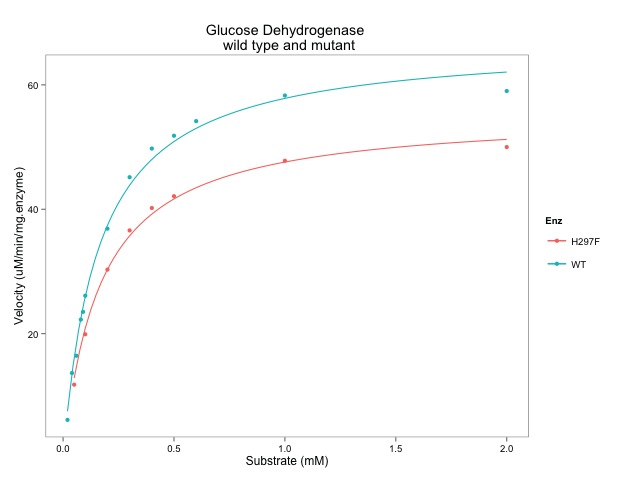You might prefer to show your graphs independently rather than overlay them.
One way to do this is to use the par() function to divide your plotting area into two pieces.
par() is discussed here in the R Function of the Day archive and is mentioned here on the Quick R pages.
As with all functions, the syntax is important.
To plot two graphs, side by side this is the code: par(mfrow=c(1,2))
To plot four graphs, arranged in 2 rows and 2 columns, this is the code: par(mfrow=c(2,2))
It's good to know how to reset the layout: par(mfrow=c(1,1)) # back to one graph
So here's the output:
Here is the script (again with repetition for understanding):
### I have detailed lots of things separately so that it's obvious what I'm doing.
### The code could be made shorter and less repetitive.
### This is the data ###
# Data from multiple experiments
conc <- c(1.00E-08, 1.00E-07, 5.00E-07, 1.00E-06, 1.00E-05,
1.00E-08, 1.00E-07, 5.00E-07, 1.00E-06, 1.00E-05,
1.00E-08, 1.00E-07, 5.00E-07, 1.00E-06, 1.00E-05,
1.00E-07, 5.00E-07, 1.00E-06, 5.00E-06, 1.00E-05, 2.00E-05,
1.00E-07, 5.00E-07, 1.00E-06, 5.00E-06, 1.00E-05, 2.00E-05,
1.00E-07, 5.00E-07, 1.00E-06, 5.00E-06, 1.00E-05, 2.00E-05,
1.00E-07, 5.00E-07, 1.00E-06, 2.50E-06, 5.00E-06, 1.00E-05,
1.00E-07, 5.00E-07, 1.00E-06, 2.50E-06, 5.00E-06, 1.00E-05,
1.00E-07, 5.00E-07, 1.00E-06, 2.50E-06, 5.00E-06, 1.00E-05,
1.00E-07, 5.00E-07, 1.00E-06, 2.50E-06, 5.00E-06, 1.00E-05)
# First drug is called Drug 49
dead.cells49 <- c(28.6, 30.1, 34.6, 47.7, 81.7,
27.1, 27.2, 35, 47.9, 80.6,
27.8, 27.9, 34.2, 47.9, 82.4,
31.1, 37.6, 55.7, 89.1, 84.3, 85.2,
30.8, 35.6, 55.9, 90.5, 85.2, 86.3,
32.6, 34.7, 54.1, 89.8, 84.2, 87.1,
32.2, 34.4, 46.1, 76.2, 84.3, 84.1,
31.4, 37.4, 50.5, 75, 85.3, 84.8,
27.6, 37.3, 46.3, 74.1, 81.6, 82.7,
26.7, 28.4, 27.9, 59.6, 87, 86.1)
# Second Drug is called Drug 11
dead.cells11 <- c(28.4, 28.9, 28.6, 30.1, 90,
27.8, 28.5, 29.2, 29.3, 89.9,
28.6, 26.6, 27.3, 29, 89.7,
25.8, 28.7, 31, 80.7, 85, 85.2,
25.3, 28.2, 30, 81.4, 83.5, 87.2,
25.9, 25.4, 28.4, 81.2, 81.4, 85.6,
36.4, 36.2, 33.4, 52.3, 87.2, 97,
33.9, 29.5, 32, 44.8, 84.9, 97.2,
30.1, 30.1, 31, 46.5, 83.5, 96.1,
22.8, 23.7, 25.8, 37.9, 73.8, 86.7)
# Put the data into a data frame and transform the data to make it postive for fitting
data49 <- data.frame(conc,dead.cells49)
data49$nM <- data49$conc * 1000000000
data49$log.nM <- log10(data49$nM)
data11 <- data.frame(conc,dead.cells11)
data11$nM <- data11$conc * 1000000000
data11$log.nM <- log10(data11$nM)
################## fit the data ##################
# make sure logconc remains positive, otherwise multiply to keep positive values
# (such as in this example where the iconc is multiplied by 1000
fit49 <- nls(dead.cells49 ~ bot+(top-bot)/(1+(log.nM/LD50)^slope),
data = data49,
start=list(bot=20, top=95, LD50=4, slope=-12))
fit11 <- nls(dead.cells11 ~ bot+(top-bot)/(1+(log.nM/LD50)^slope),
data = data11,
start=list(bot=20, top=95, LD50=4, slope=-12))
################## Plot the results ##################
#this lets you graph your calculated equations nice and pretty
x <- seq(0,6, length=100)
y49 <- (coef(fit49)["bot"]+(coef(fit49)["top"]-coef(fit49)["bot"])/(1+(x/coef(fit49)["LD50"])^coef(fit49)["slope"]))
m49 <- coef(fit49)
y11 <- (coef(fit11)["bot"]+(coef(fit11)["top"]-coef(fit11)["bot"])/(1+(x/coef(fit11)["LD50"])^coef(fit11)["slope"]))
m11 <- coef(fit11)
# This is the key bit of code that divides the plot area in two
par(mfrow=c(1,2))
# plot the first graph - goes on the left side
plot(data49$nM, data49$dead.cells49,
log="x",
main="Drug 49",
xlab="Drug concentration (microM)",
ylab="Dead cells (% of cells)",
xlim= c(500, 10000),
ylim= c(20,100),
xaxt = "n") # suppresses the labels on the x-axis
# order here is important
# you have to complete the plot before you start the next one
# adds the axis they way we want it to look
axis(1, at=c(500, 1000, 2500, 5000, 10000), lab=c("0.5","1","2.5","5","10"))
# adds the non-linear fitted line to the first graph
lines(10^x,y49, lty="dotted", col="blue")
# add the LD50s in the legend which allows nice positioning.
rp = vector('expression',1)
rp[1] = substitute(expression(LD50(microM) == MYVALUE),
list(MYVALUE = format((10^m49[3])/1000,dig=3)))[2]
legend("topleft", legend = rp, bty = 'n', cex = 0.75)
# plot the second graph - goes on the right side
plot(data11$nM, data11$dead.cells11,
log="x",
main="Drug 11",
xlab="Drug concentration (microM)",
ylab="Dead cells (% of cells)",
xlim= c(500, 10000),
ylim= c(20,100),
xaxt = "n") # suppresses the labels on the x-axis
# adds the axis they way we want it to look
axis(1, at=c(500, 1000, 2500, 5000, 10000), lab=c("0.5","1","2.5","5","10"))
# adds the non-linear fitted line to the second graph
lines(10^x,y11, lty="dotted", col="blue")
# add the LD50s in the legend which allows nice positioning.
rp = vector('expression',1)
rp[1] = substitute(expression(LD50(microM) == MYVALUE),
list(MYVALUE = format((10^m11[3])/1000,dig=3)))[2]
legend("topleft", legend = rp, bty = 'n', cex = 0.75)





No comments:
Post a Comment
Comments and suggestions are welcome.